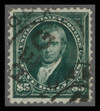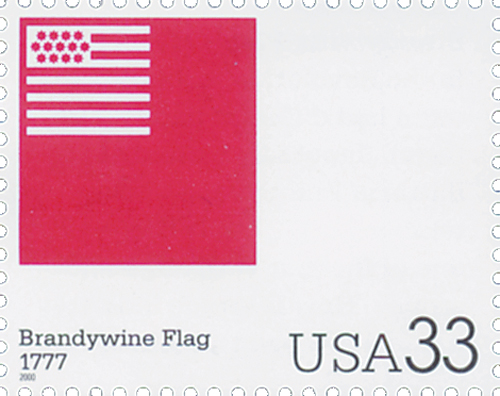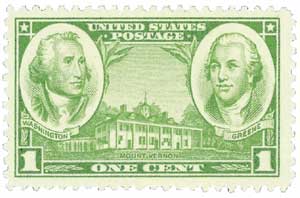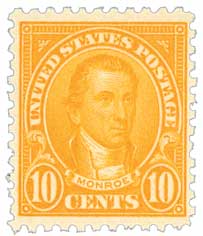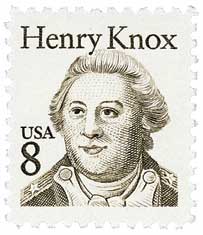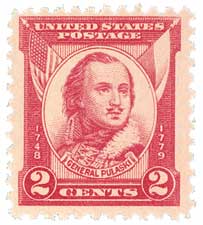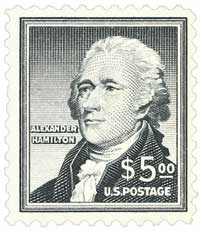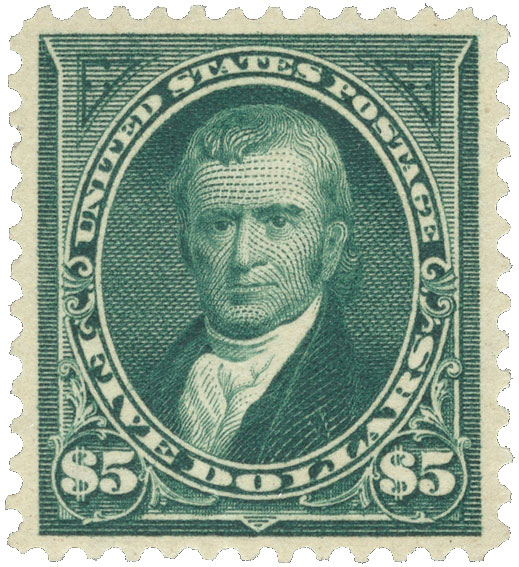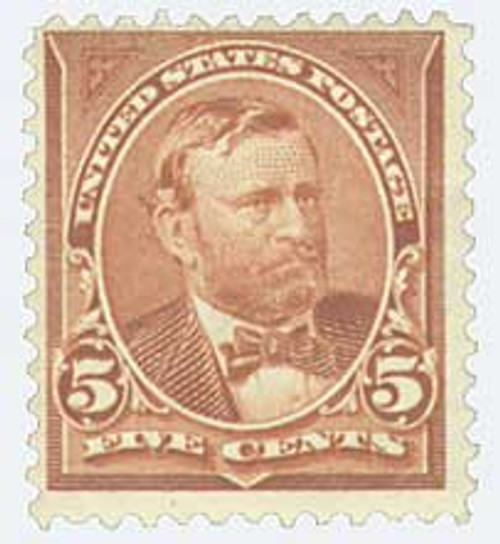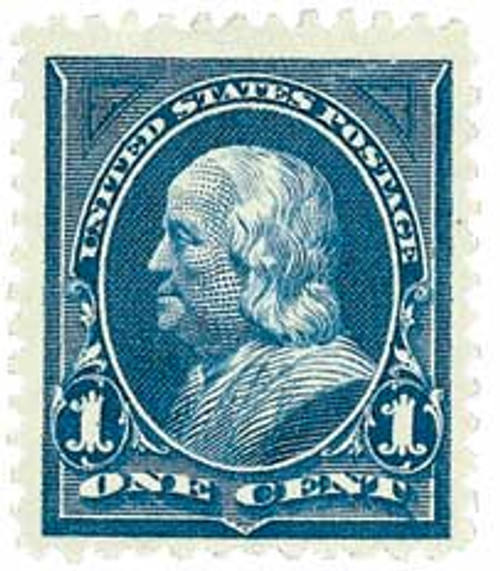
# 278 - 1895 $5 John Marshall, dark green, double-line watermark
1895 $5 Marshall
Issue Quantity: 26,965
Printed by: Bureau of Engraving and Printing
Watermark: Double line USPS
Perforation: 12
Color: Dark green
A limited quantity of $5 Marshall stamps printed on watermarked paper was issued on August 16, 1895. They were replaced by the $5 Series of 1902 stamp on June 5, 1903.
Washington Defeated At Brandywine
In August 1777, the British fleet sailed down the east coast from New Jersey to Maryland. They landed about 50 miles from the American capital of Philadelphia, Pennsylvania, which they planned to capture.
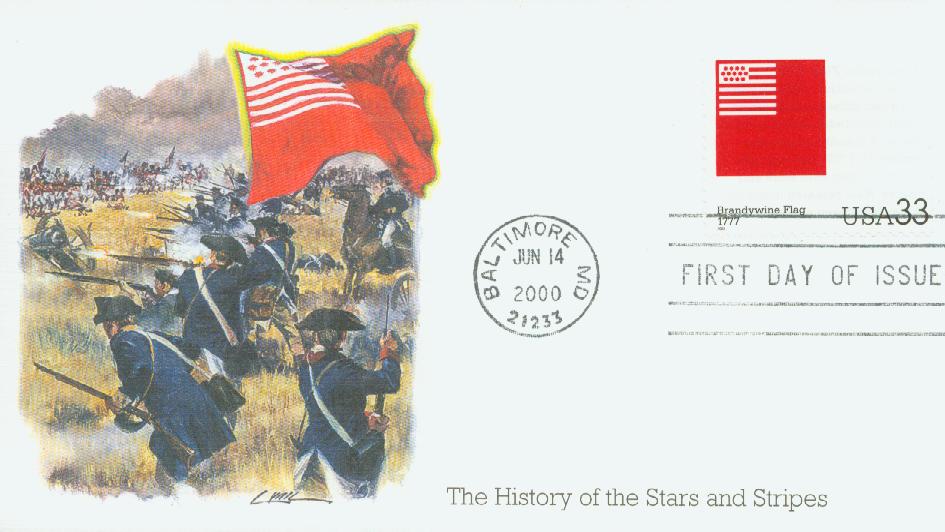
Suspecting the British plans, General Washington positioned his forces between the two points, at Chadds Ford. He also had troops at several other nearby river crossings. Chadds Ford was the most direct route along the Brandywine River between Baltimore and Philadelphia, and Washington was sure that’s where the British would attack.
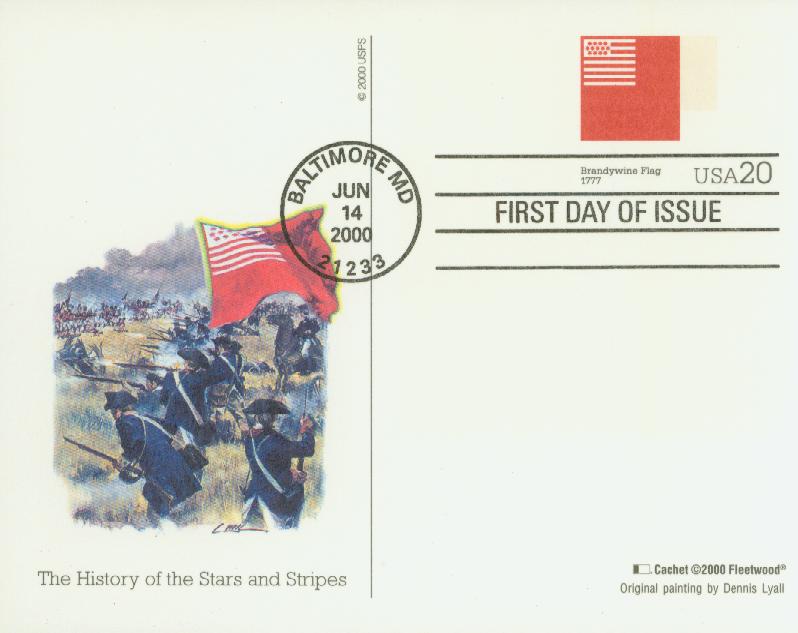
However, the British didn’t intend to attack the Americans at the center of their line. Instead, they set up a flanking maneuver and crossed the Brandywine Creek at points where Washington hadn’t stationed men.
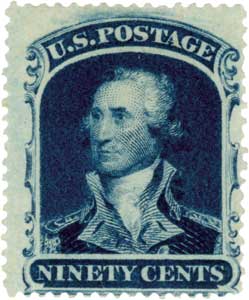
About 5:30 a.m. on September 11, under the cover of fog, British troops approached unsuspecting Americans stationed on the Great Road near the creek. The first battle of the day was fought there on the ground of a Quaker meetinghouse that continued their service despite the action outside. The battle continued throughout the morning, with the British reaching the American right flank around 2 p.m.
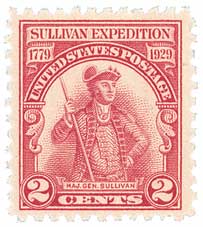
Fortunately for the Americans, the British attack was slow, giving them time to position troops on high ground. Soon the Americans had no choice but to withdraw. Major General John Sullivan and his men counterattacked, allowing part of the American line to retreat. Though reinforcements helped to delay the British advance for about an hour, they too were eventually forced to retreat. The Americans had to leave their cannons behind as most of their artillery horses had been killed.
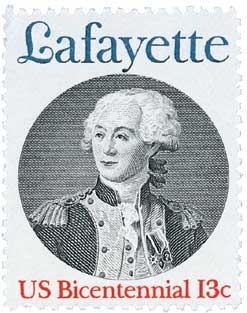
Several famous military men participated in the Battle of Brandywine. The Marquis de Lafayette was wounded during the retreat. Future president James Monroe assisted Lafayette’s physician because he spoke French. Henry Knox commanded the artillery while Anthony Wayne and Nathaniel Greene defended Chads Ford and Chads Ferry. During the retreat, Casimir Pulaski helped hold off the British forces. Other notable figures present at the battle included Alexander Hamilton, “Light Horse Harry” Lee, John Marshall, and Peter Muhlenberg.
The British attack ended at nightfall. A few small battles broke out in the coming days and the Americans then abandoned Philadelphia. The British occupied the city on September 26 and remained there until the following June.
According to legend, the Seventh Pennsylvania Regiment carried the unique Brandywine flag at the Battle of Brandywine. Referred to as a flag within a flag, the canton in the upper-left corner contained a 13-stripe and 13-star flag. The stars were arranged in three horizontal rows, and the top and bottom stripes were white. The remainder of the flag was red, perhaps a reflection of Washington’s own coat of arms.
1895 $5 Marshall
Issue Quantity: 26,965
Printed by: Bureau of Engraving and Printing
Watermark: Double line USPS
Perforation: 12
Color: Dark green
A limited quantity of $5 Marshall stamps printed on watermarked paper was issued on August 16, 1895. They were replaced by the $5 Series of 1902 stamp on June 5, 1903.
Washington Defeated At Brandywine
In August 1777, the British fleet sailed down the east coast from New Jersey to Maryland. They landed about 50 miles from the American capital of Philadelphia, Pennsylvania, which they planned to capture.

Suspecting the British plans, General Washington positioned his forces between the two points, at Chadds Ford. He also had troops at several other nearby river crossings. Chadds Ford was the most direct route along the Brandywine River between Baltimore and Philadelphia, and Washington was sure that’s where the British would attack.

However, the British didn’t intend to attack the Americans at the center of their line. Instead, they set up a flanking maneuver and crossed the Brandywine Creek at points where Washington hadn’t stationed men.

About 5:30 a.m. on September 11, under the cover of fog, British troops approached unsuspecting Americans stationed on the Great Road near the creek. The first battle of the day was fought there on the ground of a Quaker meetinghouse that continued their service despite the action outside. The battle continued throughout the morning, with the British reaching the American right flank around 2 p.m.

Fortunately for the Americans, the British attack was slow, giving them time to position troops on high ground. Soon the Americans had no choice but to withdraw. Major General John Sullivan and his men counterattacked, allowing part of the American line to retreat. Though reinforcements helped to delay the British advance for about an hour, they too were eventually forced to retreat. The Americans had to leave their cannons behind as most of their artillery horses had been killed.

Several famous military men participated in the Battle of Brandywine. The Marquis de Lafayette was wounded during the retreat. Future president James Monroe assisted Lafayette’s physician because he spoke French. Henry Knox commanded the artillery while Anthony Wayne and Nathaniel Greene defended Chads Ford and Chads Ferry. During the retreat, Casimir Pulaski helped hold off the British forces. Other notable figures present at the battle included Alexander Hamilton, “Light Horse Harry” Lee, John Marshall, and Peter Muhlenberg.
The British attack ended at nightfall. A few small battles broke out in the coming days and the Americans then abandoned Philadelphia. The British occupied the city on September 26 and remained there until the following June.
According to legend, the Seventh Pennsylvania Regiment carried the unique Brandywine flag at the Battle of Brandywine. Referred to as a flag within a flag, the canton in the upper-left corner contained a 13-stripe and 13-star flag. The stars were arranged in three horizontal rows, and the top and bottom stripes were white. The remainder of the flag was red, perhaps a reflection of Washington’s own coat of arms.






